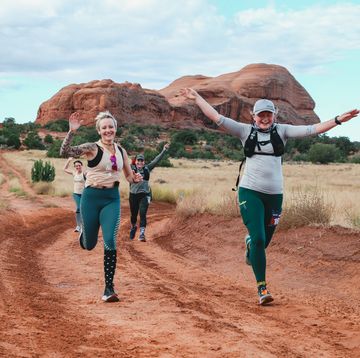Seasoned runners know that long runs, tempo runs, and speedwork are all critical to improving performance. What's more challenging, perhaps, is scheduling these sessions so you get the most out of each effort. "It's important to time your workouts correctly, and a lot of runners do it wrong," says Jason Fitzgerald, a Washington, D.C.—based coach, 2:39 marathoner, and founder of StrengthRunning.com. Getting the right amount of rest between quality workouts and before races helps the body recover and adapt, while knowing the best time of day to do certain runs can yield a more productive session. Clearly, whenever you can get out and run is when you should run—but if you've got options, here's how to time everything just right.
Go Long in the A.M.
"One of the primary reasons to do a long run is to improve fat-burning metabolism," says Scott Fliegelman, a coach in Boulder, Colorado, and founder of FastForward Sports. So going for a long run after 10 to 12 hours of fasting and just a small prerun meal is a good way to coax your body into burning fat for fuel. Morning is also the time when both core body and ambient temperature tend to be the lowest, so you're less likely to overheat if you have to be out there awhile, says Shawn Youngstedt, Ph.D., an associate professor in the Department of Exercise Science at the University of South Carolina. And because most races happen in the a.m., it's the logical time for a dress rehearsal.
Run Hard in the P.M.
"A lot of data suggests that running performance, specifically over shorter durations, is superior in the late afternoon or early evening," says Youngstedt. Indeed, in his own research, Youngstedt found that swimmers performing all-out, 200-meter trials turned in considerably slower times in morning sessions compared with afternoon and evening sessions. Researchers have found that muscle power, reaction time, and aerobic capacity are all at their peak later in the day. Core body temperature also rises in the late afternoon, loosening up muscle fibers, which might leave runners less vulnerable to injury. Plus, Fliegelman says, the day's meals have replenished the carbohydrate stores necessary to fuel quick bursts at the track or the "comfortably hard" effort of a tempo run. If you can't swing late-day speed sessions, do them when you can: "They're going to have the same benefit for fitness and race preparation even if you might not be able to go as fast," says Youngstedt.
Stagger Quality Sessions
Different workouts tax different energy systems. Which means you don't have to be completely recovered from say, speedwork, before doing a tempo run. Generally, most runners can schedule dissimilar quality sessions two to three days apart. The key is to allow enough recovery time between similar workouts. According to Olympic marathoner Pete Pfitzinger, coauthor of Advanced Marathoning, seasoned runners generally need a minimum of five days between speed sessions, four days between tempo runs, and four days between long runs; less-experienced runners may need five to seven days between each. "People sometimes cram too many quality workouts without enough rest in between," says Fitzgerald. "Their bodies are in a constant state of borderline overtraining, so they don't adapt and they don't improve." If for some reason you must do two hard workouts in a row, take two consecutive recovery days—cross-train, rest, and/or run easy, says Pfitzinger.
Take the Long View for Races
"It's a gradual progression, over weeks and months, where things get more difficult and more race-specific," says Fitzgerald. Build in a recovery week every three to four weeks, and avoid burnout by scheduling no more than four to six weeks of track sessions. Prior to event day, do your final long run seven to 21 days out (depending on race length) and your last race-specific speed workout four to 10 days out. The more experience you have and the loftier your time goal, the closer to race day you can do final key runs, says Fliegelman.













